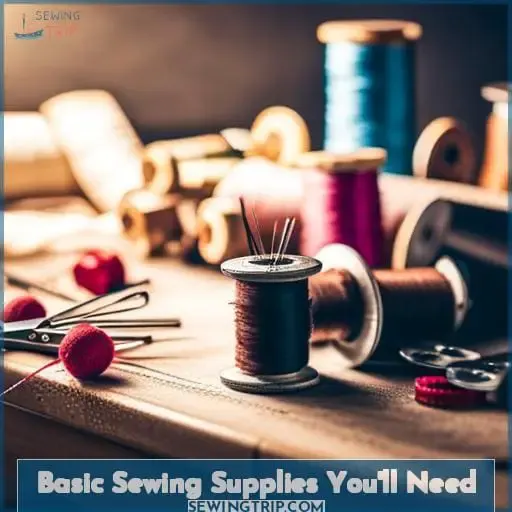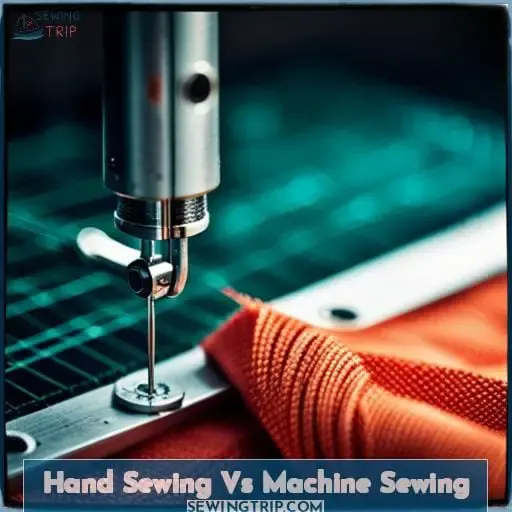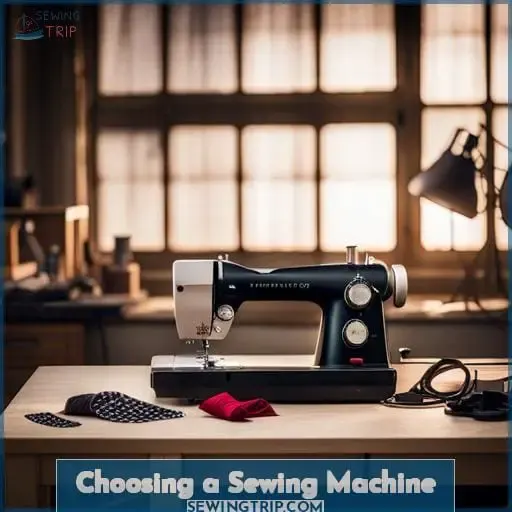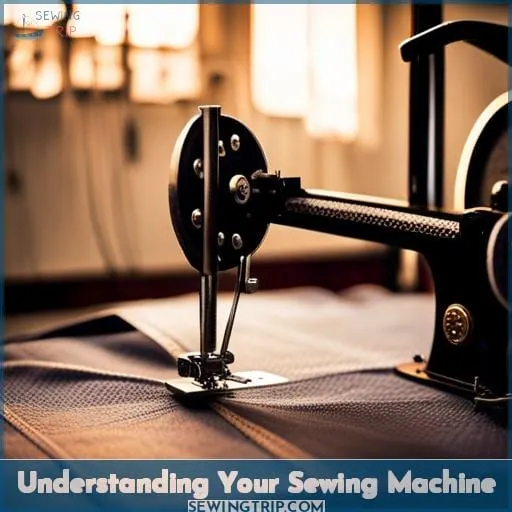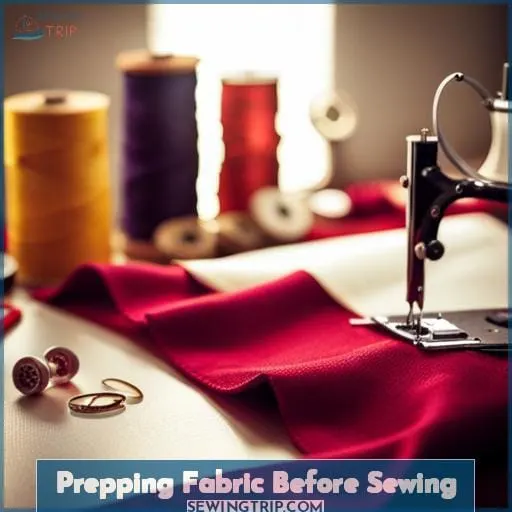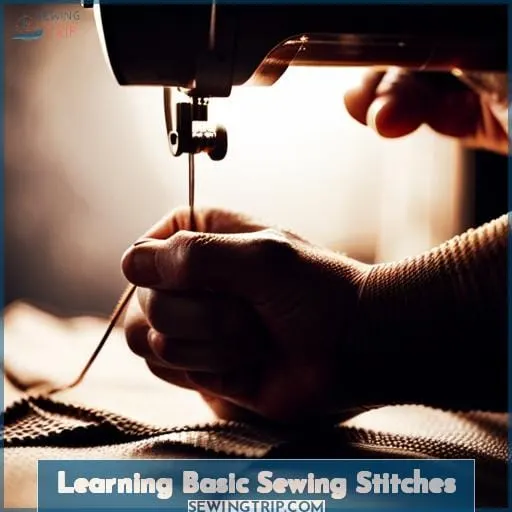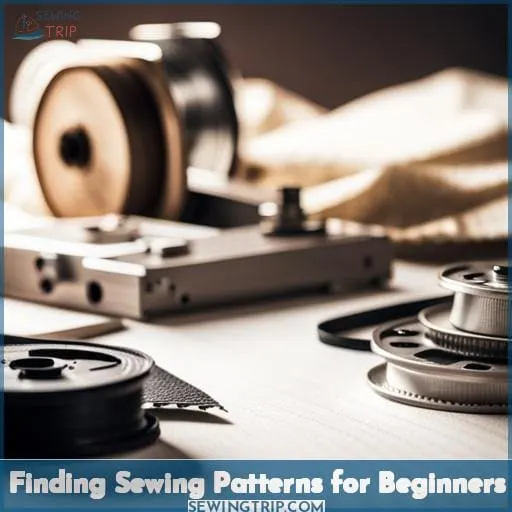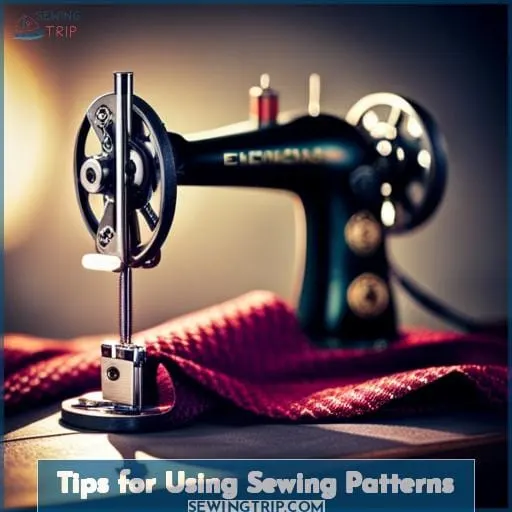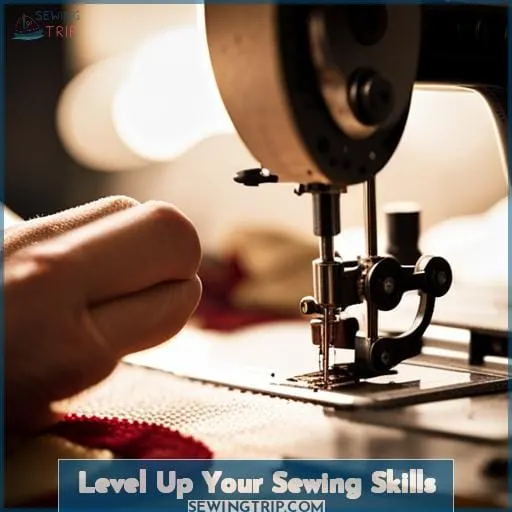This site is supported by our readers. We may earn a commission, at no cost to you, if you purchase through links.
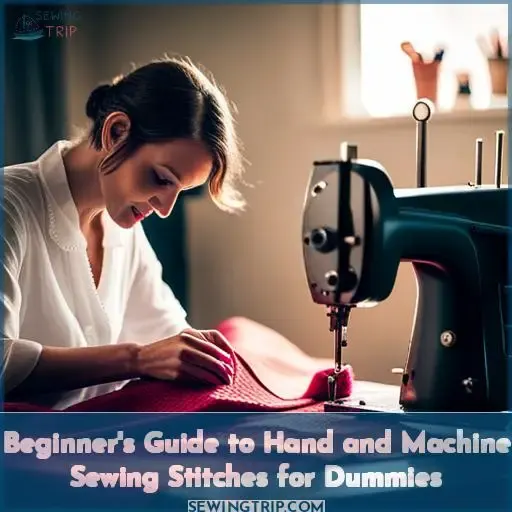 Let’s get stitching!
Let’s get stitching!
I’ll walk you through hand and machine basics so you can start sewing like a pro.
We’ll tackle supplies, stitches, patterns – even mistakes to avoid.
With some practice and patience, you’ll be creating unique projects and expressing your style in no time.
Sewing opens up a world of crafting possibilities.
Follow my lead, and discover the freedom and pride of making your own clothes and gifts.
Table Of Contents
- Key Takeaways
- Basic Sewing Supplies You’ll Need
- Hand Sewing Vs Machine Sewing
- Choosing a Sewing Machine
- Understanding Your Sewing Machine
- Prepping Fabric Before Sewing
- Learning Basic Sewing Stitches
- Finding Sewing Patterns for Beginners
- Tips for Using Sewing Patterns
- Level Up Your Sewing Skills
- Frequently Asked Questions (FAQs)
- Conclusion
Key Takeaways
- Stock up on essential supplies like fabric, needles, thread, pins, scissors, and more before beginning your first project
- Learn both hand sewing and machine sewing techniques to utilize each method’s strengths
- Research and test sewing machines to find one with user-friendly features within your budget
- Always pre-wash and press fabrics prior to cutting and sewing to prep them for the project
Basic Sewing Supplies You’ll Need
Before starting any sewing project, you’ll need to gather some basic supplies.
Grab a variety of fabric types like cotton, fleece, felt, and denim to experiment with.
Don’t forget needles, thread, pins, scissors, a tape measure, and a seam ripper.
Beginners may want to opt for all-purpose polyester thread and sharps sewing needles to start.
Have stitch markers, seam gauges, and fabric chalk on hand too.
Consider an iron and ironing board to prep fabric.
For hand-sewing, keep thimbles close by.
Only buy as much fabric as your first projects require and snag a small container to organize essentials in one spot.
Making mistakes is part of learning, so be patient with yourself as you build skills.
Hand Sewing Vs Machine Sewing
Typically, hand sewing is best for small areas, tight corners, or thick fabrics, while machine sewing works faster for large projects and long seams.
When first learning to sew, focus on developing basic hand stitching techniques like running stitch, backstitch, and whip stitch.
Once comfortable hand sewing, try a beginner machine to tackle larger projects like simple tote bags or pillowcases.
As skills progress, utilize each method for its strengths – hand sewing details and machine sewing long seams.
With practice, you’ll know when hand or machine fits your project and style.
Just remember – start simple and let your creativity grow.
Choosing a Sewing Machine
When selecting a sewing machine, budget and desired features matter.
Test drive recommended models.
Shop smart by comparing prices between retailers.
The right machine for you balances affordability with the functionality you need as a beginner.
Budget and Features Matter
When choosing a sewing machine, consider your budget and desired features.
Budget Range:
- Under $150: Basic functionality, smaller stitch selection
- $150 – $300: More built-in stitches, automatic needle threader
- Over $300: Computerized options, embroidery capabilities
Features:
- Look for user-friendly features like automatic threaders to make learning easier.
- Consider if you’ll need to transport your machine to classes or workshops.
Test Drive Recommended Machines
You’ll want to test drive recommended machines before committing to buy your first sewing machine.
Machine Features
Try out different models at your local fabric store to get a feel for what features suit your needs and skill level best.
In-person Classes
Attend free sewing classes to ask questions.
Online Tutorials
Watch online video reviews to learn the pros and cons of various beginner sewing machines.
Budget-friendly Options
Consider more affordable options that still have essential functionality.
Shop Smart and Compare Prices
Two ways you can choose a sewing machine are by shopping smart and comparing prices across retailers once you’ve identified the features you need.
To Compare Prices:
Compare Brands: Research pricing for specific models at local shops and online retailers.
Read Online Reviews: Check reviews on retailer sites and independent consumer sites to get feedback on real-world use.
Check Local Options: Visit local sewing and craft stores to test machines and find special deals in your area.
Thoughtfully comparing features, prices, and reviews will help you find the best sewing machine for your needs and budget. Staying open-minded and taking time to research will lead to a satisfying purchase.
Understanding Your Sewing Machine
Once you’ve chosen your sewing machine, take time to get better acquainted with it.
Read the user manual front to back so you’ll understand how to properly thread, change settings, and troubleshoot any problems.
Practice threading and setting up for different stitches to get comfortable with the process.
Familiarize yourself with key parts like the bobbin winder, presser foot, and needle to develop dexterity.
Experiment with various stitch patterns and fabrics to gain an intuitive feel for how your machine handles different materials.
Consider taking a beginner sewing class or workshop to expand your knowledge.
With some guidance on threading techniques, stitch troubleshooting, and bobbin winder basics, you’ll be ready to start stitch pattern exploration on your own in no time.
Prepping Fabric Before Sewing
Before cutting into that pretty new fabric, pre-wash and press it to remove sizing, wrinkles, and inaccuracies for stress-free sewing.
If you fail to pre-treat fabrics, your finished garments may shrink or warp in the wash.
To prep fabrics:
| Fabric Type | Washing Instructions |
|---|---|
| Cotton | Wash in warm water, tumble dry low |
| Linen | Wash in warm water, air dry |
| Wool | Hand wash cold, air dry flat |
When pressing, lift and lower the iron rather than pushing and pulling to avoid stretching.
For wrinkle-prone fabrics like linen, use a spray starch or sizing.
Properly pretreating fabrics leads to professional-looking creations you’ll be proud to wear.
Learning Basic Sewing Stitches
We’ll go over some key hand stitches to master by hand.
We’ll also cover useful machine stitches you can try on your sewing machine.
With practice, these stitches will become second nature.
Hand Stitches to Master
Frequently, you’ll want to start with some basic hand stitches to build up your sewing skills.
Mastering basics like the running stitch, backstitch, and slip stitch will set you up for stitch precision.
Focus on needle techniques and fabric manipulation when practicing creative embellishments for sewing projects.
Simple hand stitches form the foundation for advanced sewing lessons and understanding how to sew for dummies.
Machine Stitches to Try
You’re now ready to start experimenting with basic machine stitches.
Focus first on mastering the straight stitch and zigzag stitch, which are among the most versatile and commonly used.
Adjust thread tension and stitch length for best results.
Try finishing seam allowances with zigzag stitches to prevent fraying.
After getting comfortable with utilitarian stitches, have fun personalizing projects by playing with decorative stitches like satin stitch appliques or topstitching accents.
Finding Sewing Patterns for Beginners
To find the best sewing patterns for beginners:
- Walk into your local fabric store and browse their pattern books.
- Look for simple styles like aprons, pajama pants, and tote bags.
- Don’t be afraid to ask the shopkeeper for recommendations on easy patterns they like.
Check pattern sizing carefully and look at the suggested fabrics.
Once you’ve selected a simple pattern:
- Follow the instructions carefully, step-by-step.
- Be sure to pre-wash your fabric before cutting.
As your skills improve:
- Get creative and modify patterns by mixing and matching elements from different patterns or adjusting sizing.
- With practice, you’ll gain confidence to design your own patterns.
The online sewing community also offers wonderful project ideas and recommendations for beginner-friendly patterns.
Tips for Using Sewing Patterns
When you’re ready to start sewing from a pattern, first take time to read through all the instructions carefully.
Next, check that you have all the materials listed and take accurate body measurements for any adjustments.
Then, make a muslin or test version in cheaper fabric before cutting into your fashion fabric to perfect the fit.
Adjusting Patterns
With sewing patterns, you’re oftentimes required to adjust them to fit your body’s measurements for the best-fitting garment.
Don’t be intimidated by pattern alterations.
Start by taking accurate body measurements and compare them to the pattern’s sizing chart.
Make simple size adjustments first, like shortening or lengthening seams based on your height.
Then tweak the style with changes like slimming a sleeve or shortening a hem for your desired look.
Small pattern tweaks can create the perfect personalized design with a custom fit made just for you.
Creating Your Own
After adjusting patterns to fit your measurements, you can design your own patterns from scratch.
Choose fabrics with forgiving drape and stretch like jersey knits when starting out.
Make muslin prototypes to test pattern fit before cutting into fashion fabrics.
Allow extra seam allowance to account for inevitable sewing mistakes.
Customize designs with trims, lace, embroidery, or other embellishment techniques.
Set up an organized sewing workspace with room to lay out pattern pieces.
Level Up Your Sewing Skills
Once you’ve mastered the basics, it’s time to level up your sewing skills!
Start practicing more complex techniques like buttonholes, zippers, and advanced seam finishes.
Tackle creative projects that let you play with different fabrics and textures – try an upcycled jacket from old jeans or a statement mixed media wall hanging.
Don’t worry about perfection, just have fun exploring your style.
Speaking of which, now’s the time to start customizing commercial patterns by altering the fit or changing design details to make them your own.
Keep challenging yourself to progress to the next skill level.
Take classes, read tutorials, and don’t be afraid to try something new.
With practice, patience, and a little creativity, you’ll be creating runway-worthy designs in no time!
Frequently Asked Questions (FAQs)
What are some good beginner sewing projects I can start with?
Start with simple, functional projects like tote bags or pillowcases that use straight lines and basic stitches.
Choose beginner patterns with clear instructions.
Gather materials beforehand and take your time following directions to ensure success.
Most importantly, don’t be discouraged by mistakes – they’re part of learning.
How do I troubleshoot common sewing machine problems like skipped stitches or tangled thread?
Check needle and thread first to ensure proper threading.
Rethread from spool completely, and insert a new needle if necessary.
Inspect the bobbin area for stray threads or lint buildup.
Clean the machine and oil moving parts.
Adjust thread tension if needed.
Practice threading and maintain the machine regularly to prevent future problems.
What sewing tools and gadgets are actually useful to have versus unnecessary extras?
Stay focused on the essentials:
- Quality fabric scissors
- Needles
- Thread
- Pins
- Tape measure
- Seam ripper
Extras can wait until your skills progress.
Where can I find a local sewing community to connect with for additional help and inspiration?
To find a local sewing community:
- Check with fabric stores, community centers, or schools for classes and workshops.
- Join online sewing forums or social media groups to connect with fellow sewists for help and inspiration.
What sewing blogs, YouTube channels, or online resources do you recommend for beginners?
You’ve got this!
Start with online sewing blogs and YouTube tutorials from expert crafters.
Their step-by-step advice will guide you through projects and inspire creativity.
Connecting with an online sewing community builds skills and confidence.
Conclusion
Wow, over 80% of Americans have sewing machines in their homes!
With some practice and patience, you’ll be stitching up unique creations and expressing your style in no time.
Start with hand sewing to get comfortable with needles and thread.
Then graduate to machines for faster, stronger seams.
Follow patterns at first, then experiment with your own designs.
With the Sewing Skills for Dummies guide under your belt, let your imagination run wild and enjoy the pride and freedom of making your own stylish clothes and gifts!

